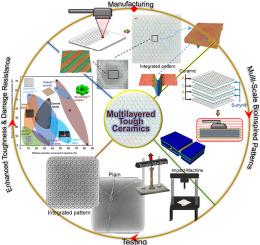Bioinspired programmable multi-scale surface architectures for toughening ceramic-polymer composites
IF 14.2
1区 材料科学
Q1 ENGINEERING, MULTIDISCIPLINARY
引用次数: 0
Abstract
Natural materials like nacre achieve exceptional toughness through hierarchical designs that integrate structural and interfacial mechanisms. Inspired by these functional principles, we present a digitally programmable laser micromachining strategy to fabricate multi-scale surface architectures on ceramic-polymer composites. By integrating full-depth hexagonal macro-patterns with shallow diagonal micro-patterns into alumina-Surlyn® laminates, we engineer surface features that simultaneously enable crack deflection, bridging, and enhanced interfacial bonding. The combined patterned configuration absorbs nearly twice the energy of unpatterned ceramics under 20 J low-velocity impacts and exhibits superior resilience under repeated 2 J impacts. Post-impact zinc-iodide X-ray radiography and rebound-based performance metrics revealed reduced delamination and partial elastic recovery in patterned samples, confirming the role of multi-scale architectures in governing damage tolerance. To probe interface mechanics, double lap joint experiments measured average interfacial shear strengths of ∼11 MPa for Plain samples and ∼18 MPa for micro-patterned samples. Cohesive-zone finite element analysis reproduced crack evolution and confirmed higher mode II strain energy release rates for micro-patterned interfaces. Together, these mechanics-based insights show how hierarchical surface patterning tailors failure pathways across both the ceramic phase and the ceramic-polymer interface. Unlike conventional macrostructural mimicry, our experimental-numerical framework offers a scalable route to toughening brittle systems and designing impact-resistant materials.

用于增韧陶瓷-聚合物复合材料的生物启发可编程多尺度表面结构
像珍珠这样的天然材料通过整合结构和界面机制的分层设计获得了非凡的韧性。受这些功能原理的启发,我们提出了一种数字可编程激光微加工策略来制造陶瓷-聚合物复合材料的多尺度表面结构。通过将全深度六边形宏观模式与浅对角微模式集成到氧化铝- surlyn®层压板中,我们设计的表面特征可以同时实现裂纹偏转、桥接和增强界面粘合。在20 J的低速冲击下,复合图案结构吸收的能量几乎是无图案陶瓷的两倍,并且在重复2 J的冲击下表现出优异的回弹性。撞击后的碘化锌x射线摄影和基于回弹的性能指标显示,在图案样品中分层减少和部分弹性恢复,证实了多尺度结构在控制损伤容限中的作用。为了探测界面力学,双搭接实验测量了平面样品的平均界面剪切强度为~ 11 MPa,微图案样品的平均界面剪切强度为~ 18 MPa。黏结区有限元分析再现了裂纹演化过程,证实了微图案化界面具有较高的II型应变能释放率。总之,这些基于力学的见解显示了分层表面图案如何在陶瓷相和陶瓷-聚合物界面上定制失效路径。与传统的宏观结构模拟不同,我们的实验-数值框架为增韧脆性系统和设计抗冲击材料提供了可扩展的途径。
本文章由计算机程序翻译,如有差异,请以英文原文为准。
求助全文
约1分钟内获得全文
求助全文
来源期刊

Composites Part B: Engineering
工程技术-材料科学:复合
CiteScore
24.40
自引率
11.50%
发文量
784
审稿时长
21 days
期刊介绍:
Composites Part B: Engineering is a journal that publishes impactful research of high quality on composite materials. This research is supported by fundamental mechanics and materials science and engineering approaches. The targeted research can cover a wide range of length scales, ranging from nano to micro and meso, and even to the full product and structure level. The journal specifically focuses on engineering applications that involve high performance composites. These applications can range from low volume and high cost to high volume and low cost composite development.
The main goal of the journal is to provide a platform for the prompt publication of original and high quality research. The emphasis is on design, development, modeling, validation, and manufacturing of engineering details and concepts. The journal welcomes both basic research papers and proposals for review articles. Authors are encouraged to address challenges across various application areas. These areas include, but are not limited to, aerospace, automotive, and other surface transportation. The journal also covers energy-related applications, with a focus on renewable energy. Other application areas include infrastructure, off-shore and maritime projects, health care technology, and recreational products.
 求助内容:
求助内容: 应助结果提醒方式:
应助结果提醒方式:


